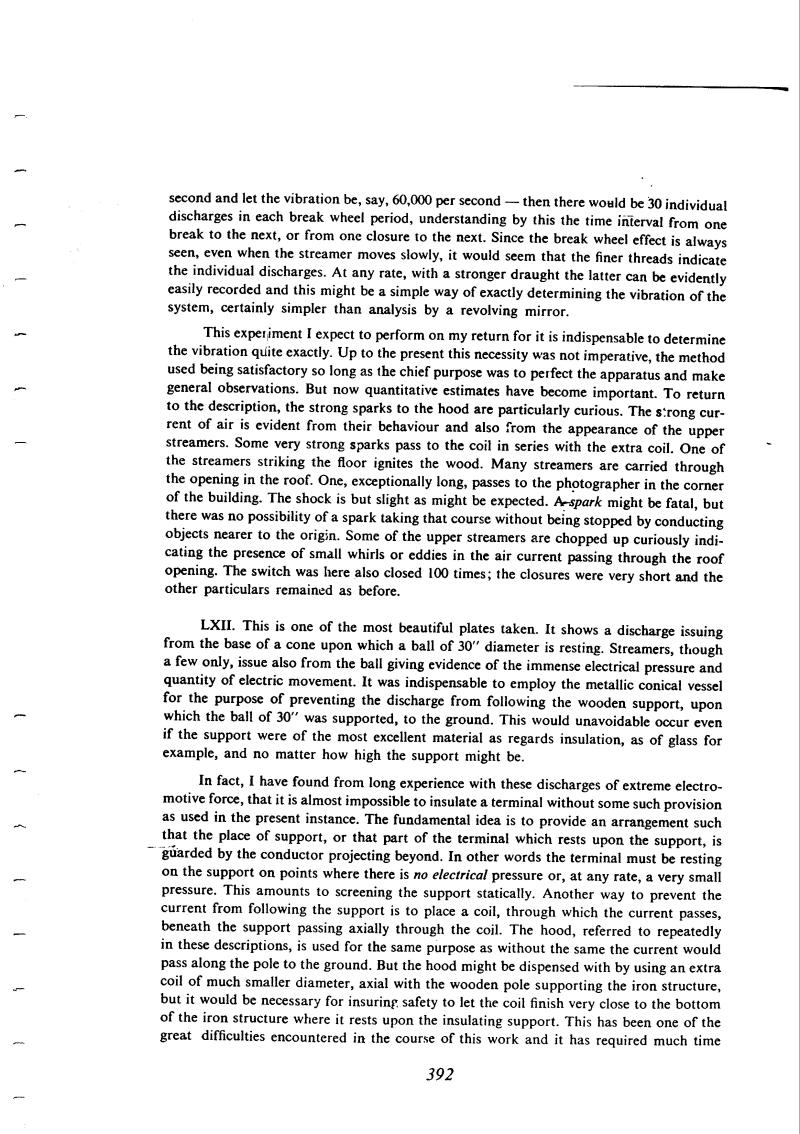second and let the vibration be, say, 60,000 per second - then there would be 30 individual discharges in each break wheel period, understanding by this the time interval from one break to the next, or from one closure to the next. Since the break wheel effect is always seen, even when the streamer moves slowly, it would seem that the finer threads indicate the individual discharges. At any rate, with a stronger draught the latter can be evidently easily recorded and this might be a simple way of exactly determining the vibration of the system, certainly simpler than analysis by a revolving mirror.
This experiment I expect to perform on my return for it is indispensable to determine the vibration quite exactly. Up to the present this necessity was not imperative, the method used being satisfactory so long as the chief purpose was to perfect the apparatus and make general observations. But now quantitative estimates have become important. To return to the description, the strong sparks to the hood are particularly curious. The strong current of air is evident from their behaviour and also from the appearance of the upper streamers. Some very strong sparks pass to the coil in series with the extra coil. One of the streamers striking the floor ignites the wood. Many streamers are carried through the opening in the roof. One, exceptionally long, passes to the photographer in the corner of the building. The shock is but slight as might be expected. A spark might be fatal, but there was no possibility of a spark taking that course without being stopped by conducting objects nearer to the origin. Some of the upper streamers are chopped up curiously indicating the presence of small whirls or eddies in the air current passing through the roof opening. The switch was here also closed 100 times; the closures were very short and the other particulars remained as before.
LXII. This is one of the most beautiful plates taken. It shows a discharge issuing from the base of a cone upon which a ball of 30" diameter is resting. Streamers, though a few only, issue also from the ball giving evidence of the immense electrical pressure and quantity of electric movement. It was indispensable to employ the metallic conical vessel for the purpose of preventing the discharge from following the wooden support, upon which the ball of 30" was supported, to the ground. This would unavoidable occur even if the support were of the most excellent material as regards insulation, as of glass for example, and no matter how high the support might be.
In fact, I have found from long experience with these discharges of extreme electromotive force, that it is almost impossible to insulate a terminal without some such provision as used in the present instance. The fundamental idea is to provide an arrangement such that the place of support, or that part of the terminal which rests upon the support, is guarded by the conductor projecting beyond. In other words the terminal must be resting on the support on points where there is no electrical pressure or, at any rate, a very small pressure. This amounts to screening the support statically. Another way to prevent the current from following the support is to place a coil, through which the current passes, beneath the support passing axially through the coil. The hood, referred to repeatedly in these descriptions, is used for the same purpose as without the same the current would pass along the pole to the ground. But the hood might be dispensed with by using an extra coil of much smaller diameter, axial with the wooden pole supporting the iron structure, but it would be necessary for insuring safety to let the coil finish very close to the bottom of the iron structure where it rests upon the insulating support. This has been one of the great difficulties encountered in the course of this work and it has required much time
392


